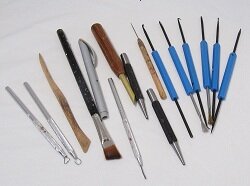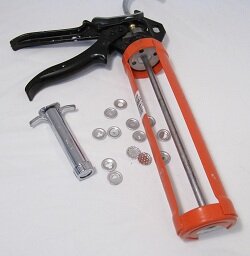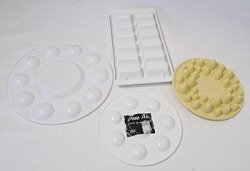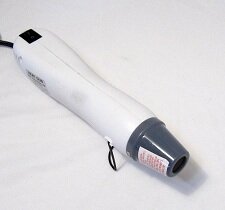Online sales are temporarily suspended !!
Contact the seller in advance before paying for the order!
Polymer Clay Tools - Part 2
 Texture and modeling tools:
Texture and modeling tools:
Welcome to polymer clay tools part two. Apart from texture plates and rubber stamps, you can texture or model your clay with things like dental tools, soldering tools and ceramic tools. These small things can make great patterns and enhancements to your polymer clay beads. Polymer clay is soft and it is three dimensional, so you can model it into fabulous shapes using these tools. Again, search around your house for things to use, like spoons, knives or chop sticks. I am sure you can find lots of things you can use as polymer clay tools that can add texture to your beads.

Clay gun/Extruder :
Clay guns are also one of those polymer clay tools that I would recommend you to buy. It is amazing what you can use it for. Everything from copying patchwork patterns, to embellishments can be done with a clay gun, or rather from what comes out of a clay gun. You can even build canes from snakes you make with a clay gun. They come with several discs that allows you to get different shapes on the snakes, like round, square, triangular, flower, just to mention some of them.
You can get several different types and brands of clay guns. Since I worked on a budget, I bought the cheapest I could get, which is the Kemper Klay Gun . But it was SO unbelievable hard to get the clay squeezed out of it, that I shelved it for a while, and decided to buy a new one. Then I remembered that we had a silicone gun in the basement, and tried to insert the clay gun into it. It worked great. One little squeeze pressed out long snakes of clay totally effortlessly.
However, if you don't have one and want to get one, I would recommend you to get one of those where you can squeeze the clay out easy, either by twisting the handle like Makin’s Professional Ultimate Clay Extruder , or get one with a “scissor grip”. They are more expensive, but will save you a lot of hard work.
You can see how you can make canes with a clay gun in this tutorial:Have Fun Caning With A Clay Gun
Bead rollers :
A bead roller is exactly what it says, a tool with which you can roll beads. You can have bead rollers that will make round, oval, tube, bicone and round beads. The sizes depend on the bead roller you use. Each roller have a small clay measure so that you will have the correct amount of clay for each bead, giving you uniform beads.
A bead roller is a very handy polymer clay tool if you are going to make many beads of the same shape. Simply make the core bead with the bead roller and then decorate it. You can also create interesting patterns if you roll a decorated bead a couple of times in the bead roller.
This great tool can also be used for other purposes, like a mold for shaping beads with a flat back side, like you can see in this tutorial:Elegant Retro Inspired Polymer Clay Bracelet. You put the clay in the bead roller, and slice of the top, so that you have one flat side and one curved side. It comes out as a long piece that you can cut in fitting pieces to make beads.
Measuring tools and templates:
When caning, you normally want slices of the same thickness. You can use a cane slicer, a regular ruler, a Poly ruler or a Donne Katos' Marxit. Poly ruler and Marxit are rulers with six sides, where each has small ridges. When you press it onto raw clay, you get small indentations with the same distance between them. Each side has different measurements. This really is one of the most fabulous polymer clay tools, that makes cutting clay like a summers breeze.
Templates of all shapes and sizes can be bought from polymer clay- or quilting suppliers. You can also make your own. I use carton or overhead sheets when I make mine. There are also templates for necklace and bracelet sizes to get.
You can make templates from scrap clay also. Sometimes you cut a shape from clay, and find that you want more of the same. In that case, bake the first piece, and use it as a template for the next ones.
Sanding and buffing supplies:
Polymer clay can be left as it is when baked, or you can sand and buff it to a higher sheen. You can make your own sanding sticks easily, by using a spatula and staple sandpaper onto it. There are also different types of sanding equipment to buy from hardware stores, and suppliers of polymer clay tools.
After sanding you can buff the bead with a piece of denim to a satiny sheen, or you can use an electric buffer with a muslin wheel, to polish it to a high sheen.
I do not buff my beads with an electric buffer, since I glaze them with liquid polymer clay, but I do buff with denim or another rough textile to achieve the satin finish.
You can use dry or wet sandpaper when sanding polymer clay. If you choose the dry sandpaper, use a protection mask so you don't inhale the dust. When wet sanding you avoid the dust problem.
Sandpaper comes in different grits. The mostly used ones are 400, 600, 800 and 1200. 1200 is the finest.

Baking trays:
To make beads in different shapes, like hollow beads, you can use a paint palette or ice cube tray. Put them upside down and use them as shapes for your beads. You can bake the beads on the trays, but, since they mostly are made of plastic,test them out so you are sure they don't melt during baking. Polymer clay is baked at low temperatures, so it is probably no problem, but check it out anyway, so you don't get some unpleasant surprises.
Light bulbs are also nice to use if you want a curved piece. Use toilet rolls for bracelet shapes. Search your house, you will find a lot of things you can use to bake and shape clay on and with.
Aluminum trays are great to bake clay in. They are wide enough to rest your bamboo rods on, and you can put a lid on when you bake clay. With a lid on, you eliminate the residue and smell that occurs during baking.
paint palettes and brushes:
A paint palette can be useful polymer clay tools when you want to mix mica powders, alcohol inks or oil paint to liquid clay.
Paint brushes can be used for a lot of things, from dusting clay with cornstarch to paint the clay with alcohol inks. I use paint brushes to apply liquid clay to the beads when I glaze them. Try to get brushes that don't shed hair or trap too much air. Soft brushes are preferable when applying paint, pearlex or mica powders to raw clay. If you want the brush to make texture to your clay piece, use one with stiff hair.
Baby wipes:
When it comes to cleaning up your clay before baking, cleaning your hands, tools and pasta machine, nothing can compare to baby wipes. They are superb. They are harmless to the clay, cleans your tool easily and your hands too. Use them generously when you work. Wipe your work surface and your hands. Clean the pasta machine after you have run dark clay through it that can contaminate the next color you want to use. They are cheap and easy to come by. A real “must have” when working with polymer clay.
 Heat gun :
Heat gun :
I bought my heat gun for scrap booking, but it has turned out to be a fabulous and versatile tool for polymer clay. If you want glass like beads you can glaze them with liquid polymer clay and use the heat gun to cure it to a glassy surface. You can see how in this tutorial:Glazing Beads With Liquid Polymer Clay Gives A Glass Like Sheen To Your Beads
You can make beautiful embellishments by spreading liquid clay onto metal foil, heat it with the clay gun until clear, and then cutting out shapes you can apply onto raw clay. And it is great to heat up the foam in the shaving foam technique, leaving intriguing patterns on the surface of the beads.
You can see how this technique is used to create faux mother of pearl inlays in this tutorial: Make A Bangle With A Tin Can, Clay Gun And Faux Mother Of Pearl Inlay.
If you don't have a heat gun, I strongly recommend you to buy one. A regular heat gun like the ones you use for removing paint will be too strong and too warm for use with clay, and a hair dryer will not be hot enough and would also blow the stuff off the piece you work with. A scrap book embossing tool is perfect. It is not too hot (but will burn the clay if you go too close), it will move the liquid clay, but not if you move the gun and the bead as you heat it and add thin layers.
Use it to melt embossing powder on the surface of your beads, to glaze beads and to give interesting surface techniques to your work, like the shaving cream technique. Check out this tutorial to see how it's done: Shaving Foam -Not Just For Shaving.
I promise you that this is a tool you will never regret that you bought.
There are many other polymer clay tools to purchase, and many more you can invent your self. These, however are the most used ones. I will keep you updated as soon as I find new polymer clay tools or things that can be used as a tool. In the meantime, use your creativity and imagination and make something unique and wonderful.
Return to Part 1
Return from Polymer Clay Tools - Part 2 to Polymer Clay Basics
Go to Home Page
Leave a comment ,
I would love to hear your opinion on this page. Good or bad, it will help me making this Site better.


 Texture and modeling tools:
Texture and modeling tools:

